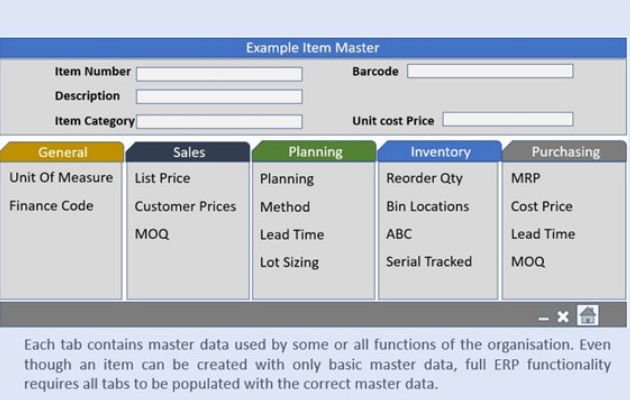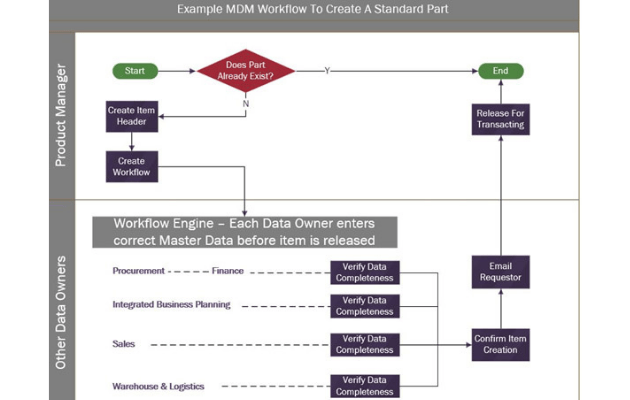5 Steps to Better Master Data Management
We all know that clean engine oil is necessary to keep the engine in your car from seizing up. When it comes to keeping enterprise software and ERP running smoothly, Master Data Management in an ERP is like the oil in an engine because when not cleansed properly, the ERP performance will suffer.
When a car needs an oil service, it goes to the garage for the day, but given the 24/7/365 uptime requirement for enterprise software, a different approach is needed. This blog explains Master and Reference Data and offers a practical, 5-step approach to Master Data Management (MDM).
Master Data and Reference Data Defined
The Data Governance Institute defines Master Data as the core entities upon which business transactions act. These include parties (e.g., customers and suppliers), places (e.g., sales territories), and things (e.g., products, items and assets).
Reference Data are sets of values or classification schemas that are referred to by systems, applications, data stores, processes, and reports, as well as by transactional and master records.
For example, every retailer who accepts credit or debit cards has a unique merchant ID to get paid. This ID includes Master and Reference Data specific to the retailer, such as their bank details, the retailer’s specific line of business, industry category and location. Card issuers make some of this data available to their customers who use online banking apps because it’s useful for analysing household spend by category e.g. grocery, utilities, clothing, footwear, entertainment and motoring. The banks use the same data themselves to make lending and direct marketing decisions, based on an individual customer’s spending habits.
Master and Reference Data are crucial in the application of business rules, process automation and data visualisation and if incomplete or incorrect, system performance and decision-making quality can be compromised.
The following are 5 steps to better management.
Step 1: Get everyone to own Master Data Management
At Lumenia, we regularly encounter two common misconceptions about MDM. The first is “…. This is something that the IT team should be doing?” Unfortunately, it’s not true – MDM must be owned by everyone in the organisation. The responsibility for maintaining accurate customer Master Data will rest with the Sales or Commercial group. For supplier Master Data, it would be the Purchasing or Supply Chain group, for finance, the Financial Controller and so on. Whilst multiple, cross functional groups collaborate within an end to end process, each function owns its own pieces of the Master Data jigsaw within it. Yes, the IT manager will own ERP uptime and performance, but he/she won’t be transacting within it to any great extent, whereas the other functions are constantly creating, retrieving, updating and deleting Master Data.
The second misconception is “…. surely the new ERP software will take care of this?” In reality, whilst many ERP products come with excellent data migration and case management functionality, a significant resource commitment remains. This work is often performed ancillary to an individual’s primary role and can be split into three MDM role descriptions.
- Data Owners are the MDM subject matter experts for their own functional area and perform the work of creating, changing Master Data in response to requests from the organisation.
- Data Stewards are typically functional leads with deep functional knowledge in their own area and cross functional peer relationships. They manage approvals, ensure service levels and implement MDM policy.
- The MDM Sponsor is responsible for MDM strategy and governance and will always be a senior executive with a vested interest. They will use their influence to remove organisational roadblocks and arbitrate at the most senior level.
Step 2: Standardise naming conventions and categories
Master and Reference Data within the same category should be created in a standardised format throughout the organisation, ideally before any transactions take place.
For example, in the Finance business process, if every local business unit or entity uses the same general ledger naming and numbering convention in their part of the ERP, the group CFO can more easily prepare consolidated reports and accounts, without manipulating them first in Excel. Correspondingly, the same applies to a local Finance Manager when drilling right down to analyse spend. Good MDM practice is to first verify that a new item such as a part number or expense code doesn’t already exist, before creating it to a defined convention within the existing hierarchy.
Step 3: Ensure a single source of correct Master and Reference Data from the outset
Ideally, the most appropriate place to hold Master and Reference Data is in the ERP system – not in Excel, which over time, can get corrupted or spawn multiple versions. At the outset, getting the right Master Data into the appropriate data fields during item creation for example will eliminate MDM related problems further downstream.
For example, in a Quotation to Cash process, fast quote turnaround times can help close more sales. When a sales agent needs to lookup previous similar quotes or products, they can do it faster and better when someone before them has entered enough accurate information in an item master or quote to enable search using specific keywords. The same rule applies further downstream for automated fulfilment processes, analysis and reporting.
Figure 1 below illustrates a (very simplistic) item master record with 25 different data fields. If the item master doesn’t specify the MRP parameters or supplier lead time, inventory may run out in the warehouse. Equally, if the Serial Tracking flag is unchecked, the quality team will find it difficult to perform a product recall.

Figure 1: Typical ERP Item Master
Step 4: Control how Master Data gets created, updated and deleted
Use role-based permissions to lock specific transactions down in the ERP. There should be a documented MDM policy, process and separation of duties between requestors, approvers and processors, and clear lines of responsibility. Change controls should include an impact and risk assessment prior to approval.
Figure 2 below illustrates a workflow commonly used to achieve this in item master data maintenance.
- The Product Manager first checks that the new item doesn’t already exist before triggering a workflow to the other Data Owners.
- The workflow routes the request to Data Owners who each add the elements of Master Data for which they are responsible.
- Prior to releasing the part for use in the ERP, there is a confirmation step to ensure all the tabs (Figure 1) are populated correctly.

Figure 2: Typical item creation workflow
Step 5: Remove Barriers, Handoffs and Bottlenecks
We humans are inherently very good at circumventing rules to get things done faster. Promote engagement and buy-in by incorporating Lean design principles into the MDM process. The following are some examples:
- Point and click is faster, easier and lower risk than entering long text. Replace free text with drop down menus, each with the appropriate list of references that users can easily select.
- Before agreeing on a process step, handoff or approval, analyse its value to determine if it belongs at all and if its an enabler or barrier.
- Use system generated item numbers and reason codes instead of attempting to build in logic. Eventually, the logic that you carefully designed will break because no-one remembers the rules anymore or more often, a customer demands a workaround.
- Standardise the process for handling requests from the business to create, update and delete Master Data. Maintaining a customer focus, visibility and respecting published service level agreements will ensure stakeholder buy-in and manage expectations.
Summary
These 5 steps should be applied regardless of business systems or ERP product used. Equally, they apply in both fixed state operations and during an implementation project. If you are implementing a new ERP, regardless of how clean Master Data is at cutover, without a perpetual, effective MDM process that is adequately resourced, old issues will reappear over time and, like dirty engine oil, eventually affect the performance of your ERP.
This blog was written by Eoin Fanning, Principal Consultant at Lumenia Consulting. For further information please send an email to Eoin Fanning. Or to find out more on MDM, download Lumenia’s Report - Who's Minding Your Master Data? from the Publications Section of this website.


